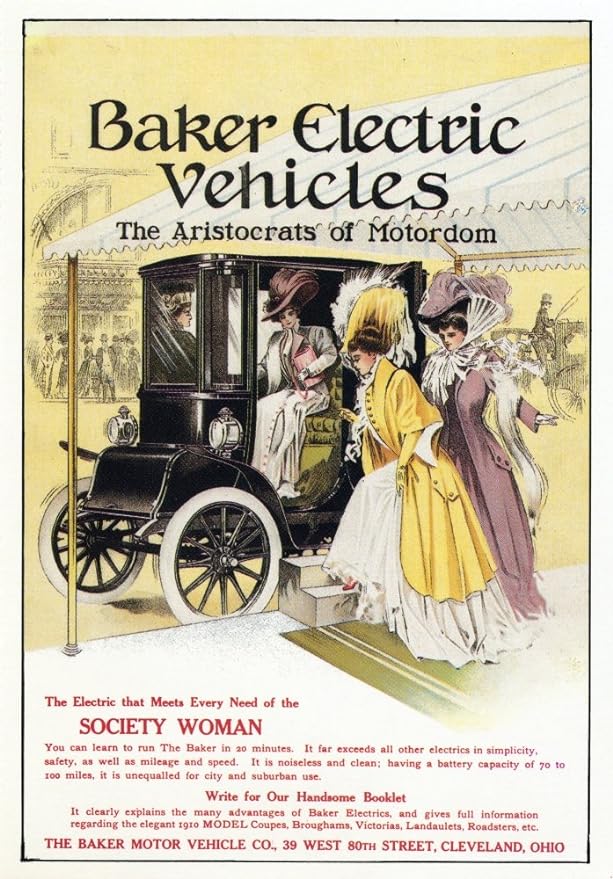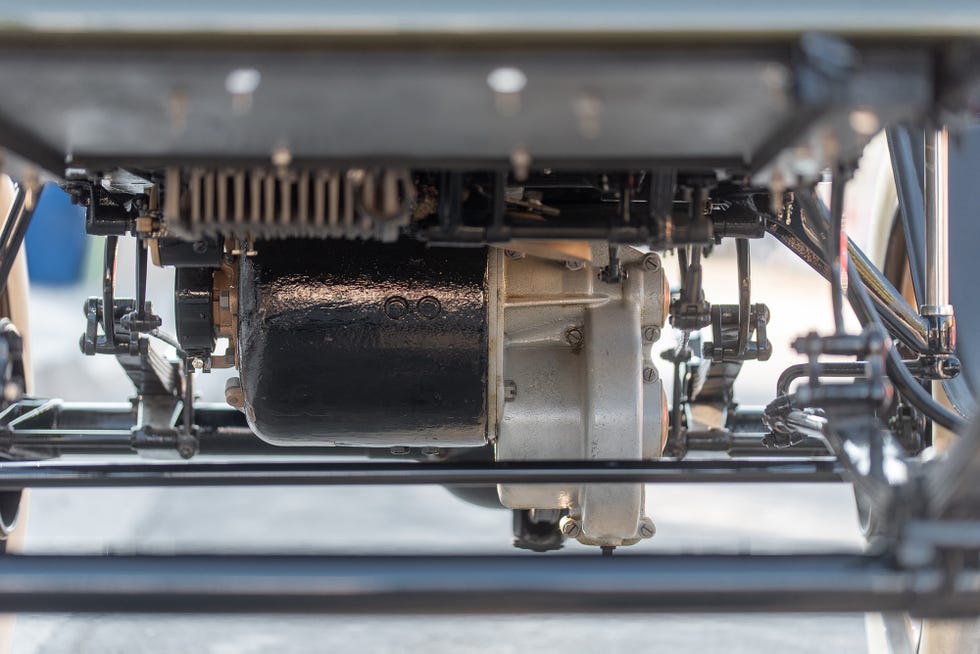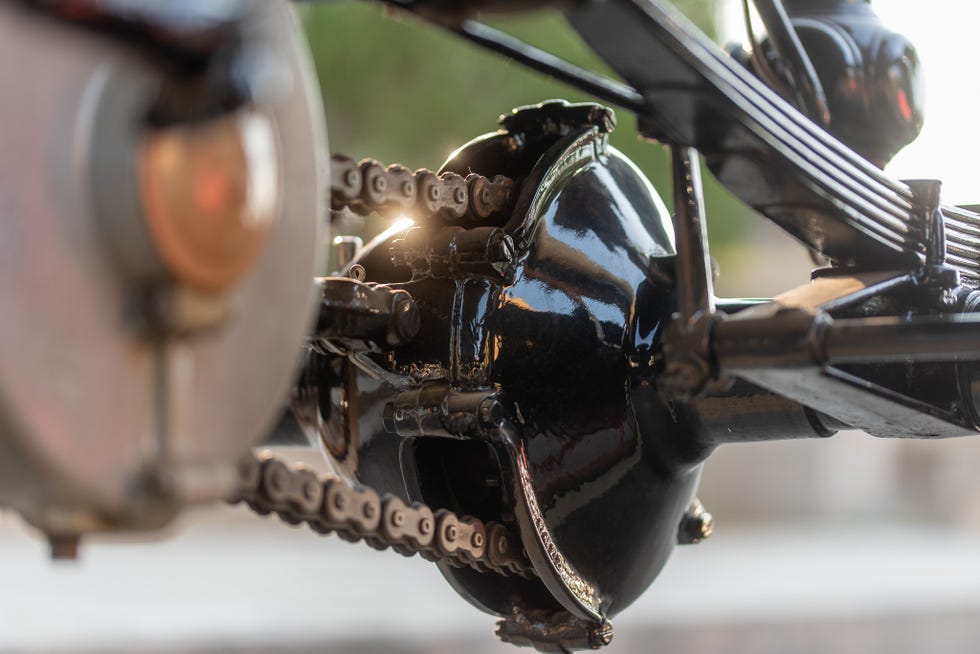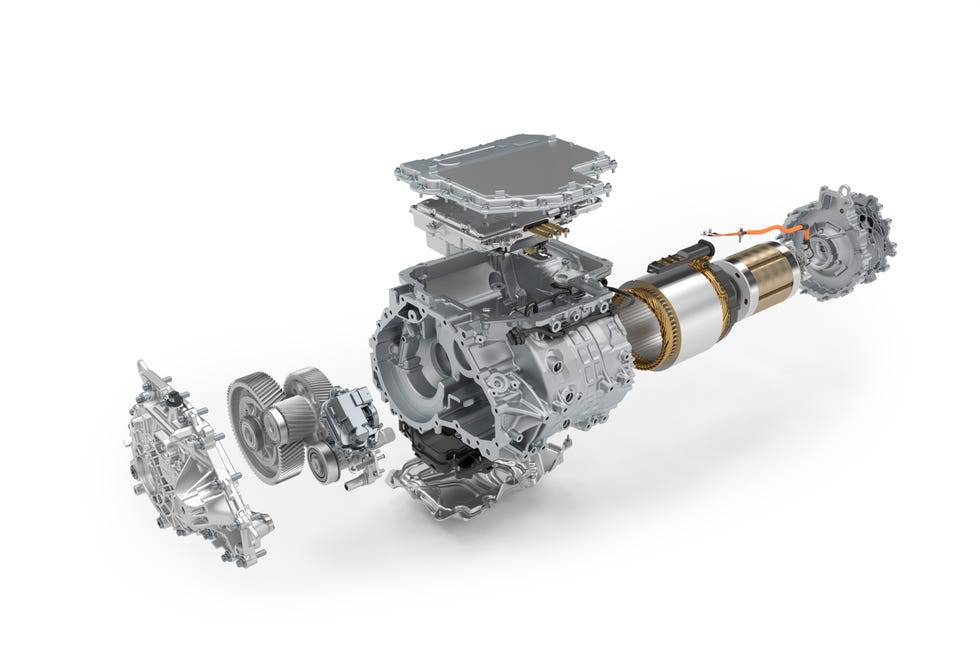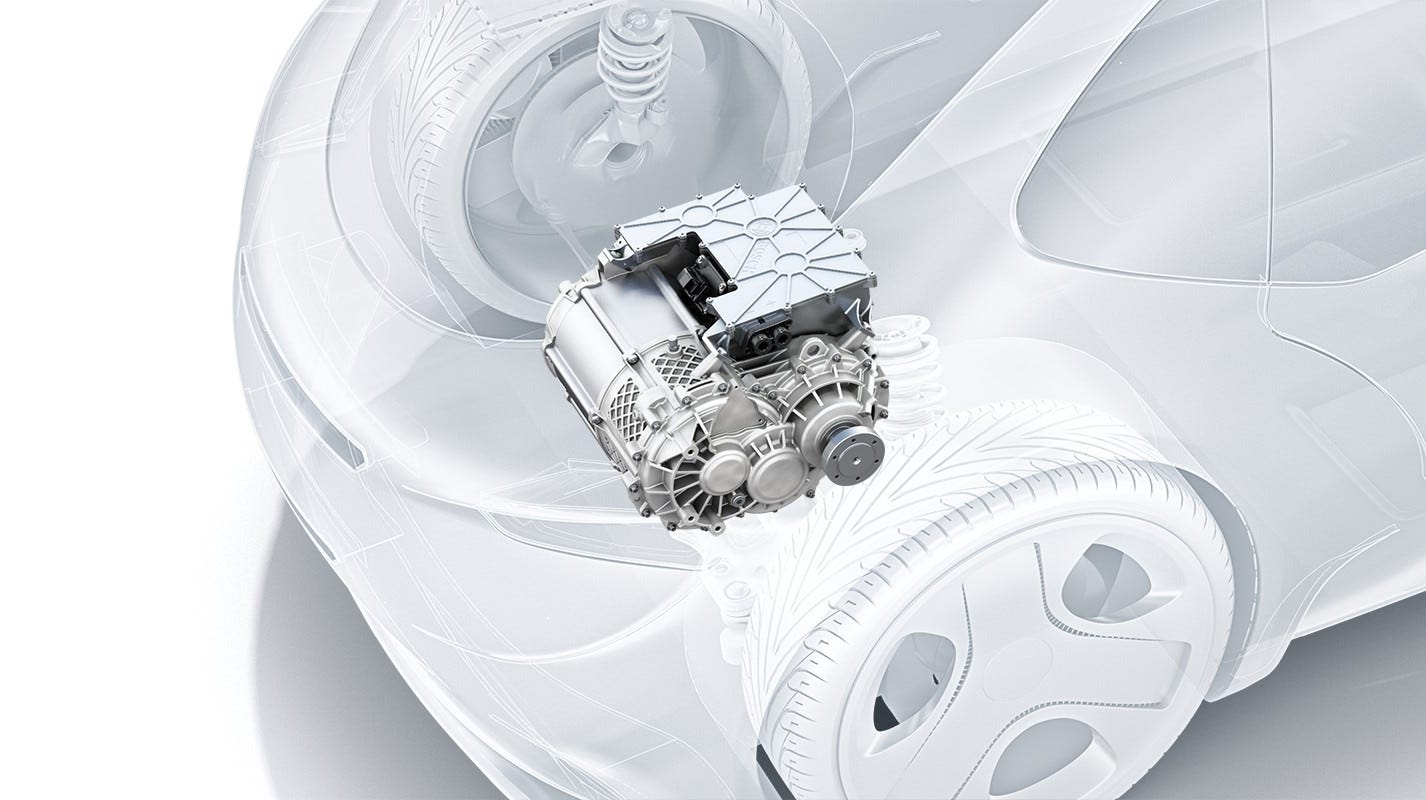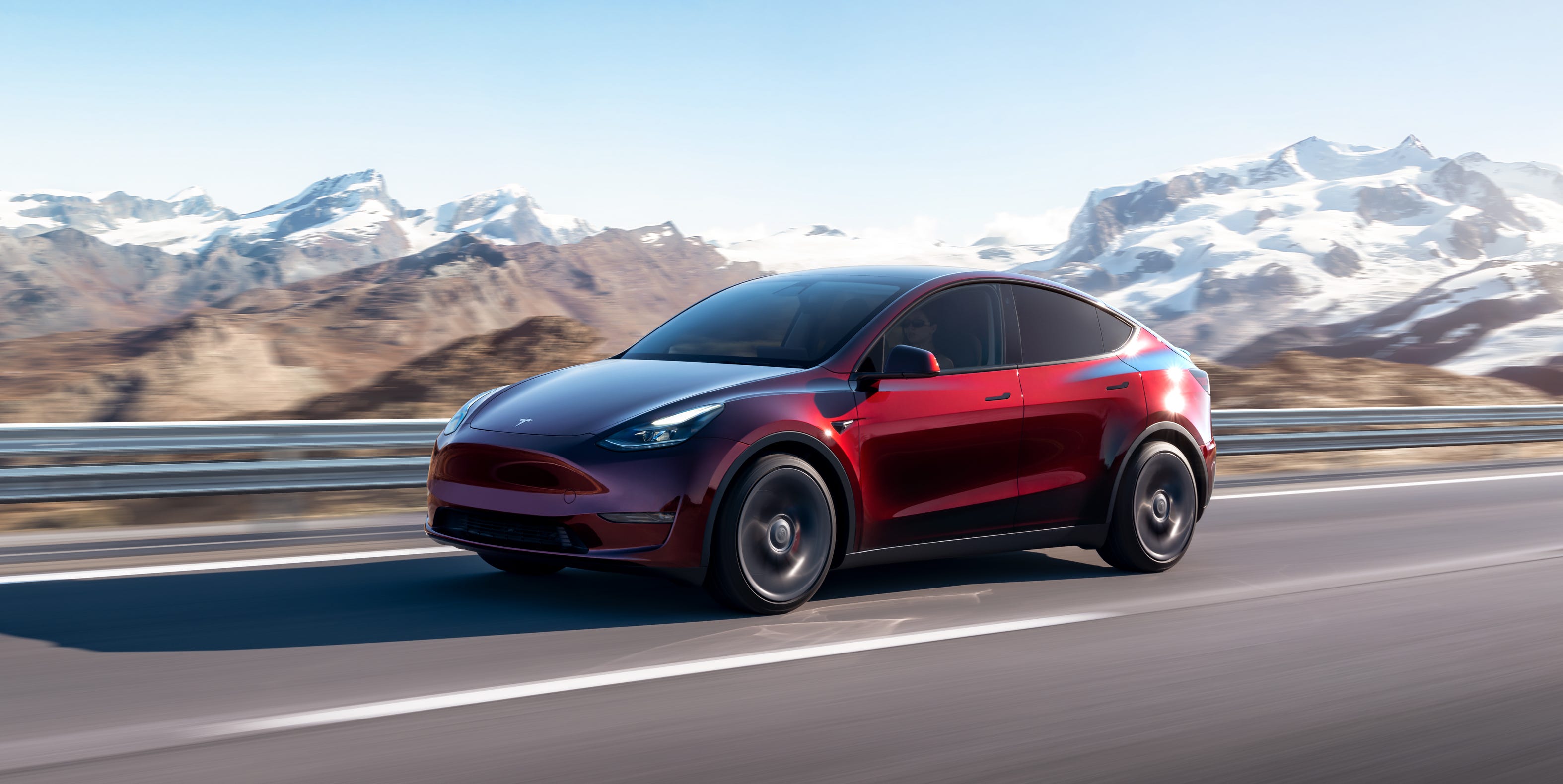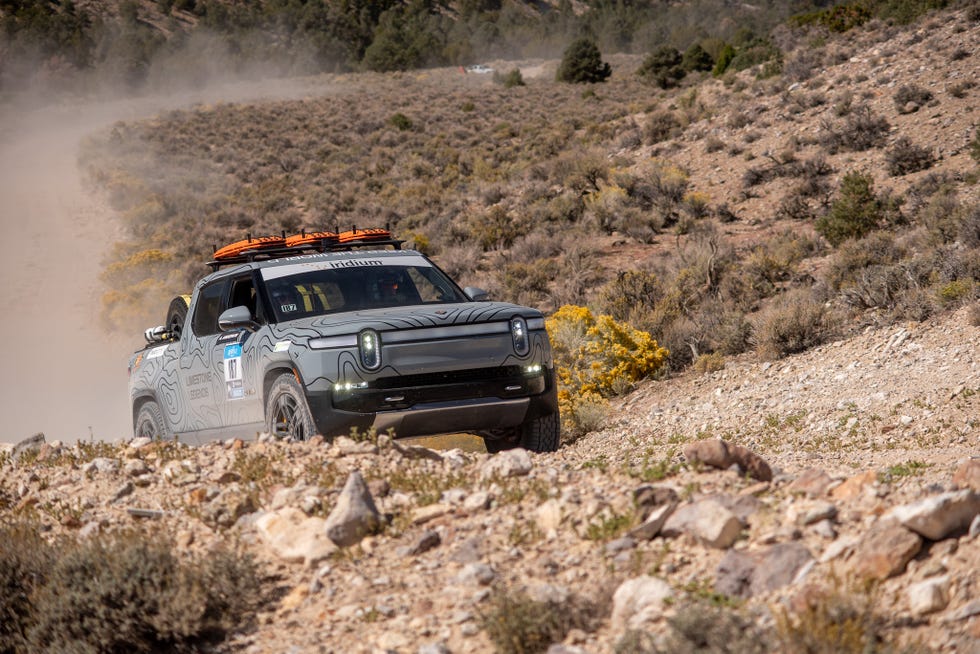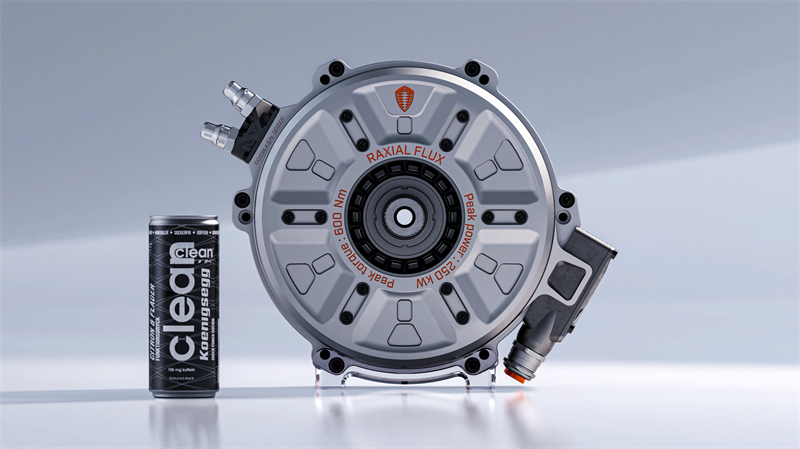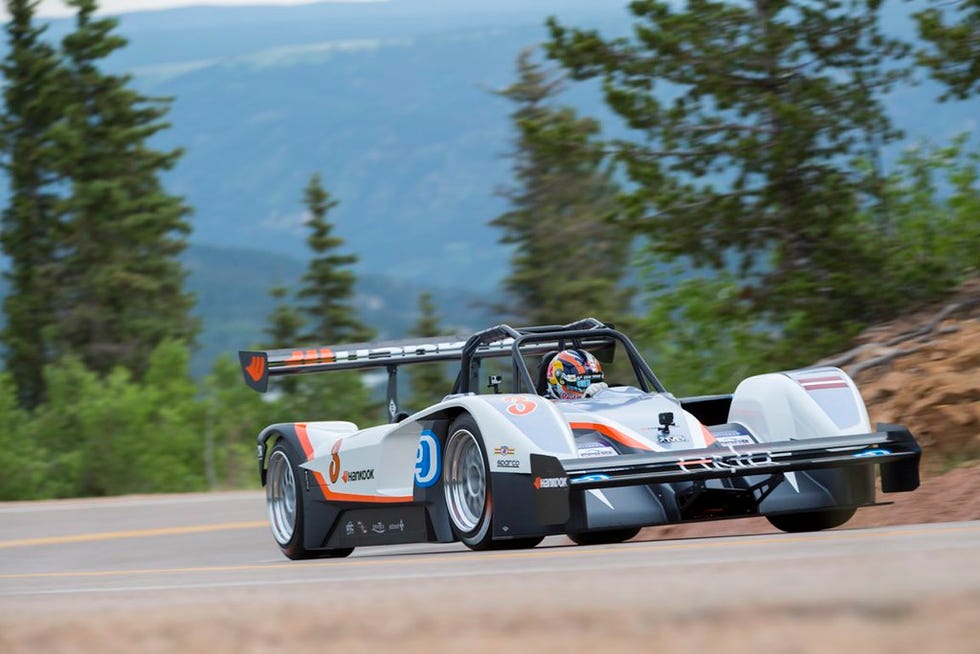Any enthusiast will be able to tell you the seat-of-the-pants characteristics of their favorite engine. The torque-peakiness of an Eighties turbo car, the endless rev-hungry climb of a naturally aspirated Honda, the gut-wrenching low-end torque of a Detroit V8—combustion cars all have different styles to deliver their power. This variety is part of what makes the automotive world so fun (and gives automotive reviewers like me a job to do), and it’s understandable that a common complaint leveled at the coming wave of electric vehicles is that they will eliminate this diversity. After all, an electric motor is an electric motor, isn’t it?
It turns out that electric motors—like many other components in EVs—are not all made equally, and the way they’re constructed can radically alter torque and power delivery characteristics. While auto journalists aren’t yet singing the praises of permanently excited magnets or axial-flux motors like they would turbochargers or V-8s, that might change as motor tech continues to advance, and the motors of tomorrow are lighter, more powerful, and even more interesting to drive.
Brushing Up On Some History
To understand how electric motors can differ, we have to understand the general principle through which they work. The main goal of an electric motor is to convert electric power to mechanical energy. There are many, many ways to achieve this, but most electric motors use the same two core components: A stator and a rotor. The stator is a stationary magnet; the rotor is a rotating assembly that is alternatively magnetically attracted and repulsed to the field of the stator. By varying the magnetic field inside of the motor (by rapidly changing the polarity of either the rotor or the stator), the rotor spins. That rotation is how electric motors make things—including cars—go; it simply turns out there are many, many ways to magnetize things and make the rotor spin.
The first EVs—not the Tesla Roadster or the Nissan Leaf, but the electric carriages dating to before the dawn of the 20th century—used the simplest style of electric motors, also known as brushed (direct-current) motors. These motors have a wire coil directly on the rotor, and magnets on the stator. Rotation of the rotor is accomplished by reversing the electrical current to the wire coil on it, and changing its electromagnetic field to continually oppose the magnets on the stator.
Reversing the current is done via “brushes” located on the rotor. (These brushes were originally bundles of wire that looked like brushes; in modern applications, they are made of solid slabs of carbon graphite.) The brushes make contact with a device called the commutator located on the stator. The commutator reverses the current direction flowing to the rotor wires, flipping the electromagnetic field, and allowing the rotor to continue spinning. Brushed motors work with direct current (DC), which is the way that energy is delivered natively via an EV’s battery pack.
According to Parvalux, an electric-motor manufacturer that builds brushed motors, the upsides of this arrangement are extremely high initial torque as well as much lower cost than most other motors, thanks to their lack of complexity. The downside, of course, is that the brushes physically contact the outside edges of the motor, which creates friction and reduces efficiency. This friction causes the brushes to wear out and require replacement. The heat generated also limits the top sustained speeds a brushed motor can attain.
For these reasons, brushed motors had entirely fallen out of favor for automotive applications for decades until BMW’s most recent iteration of its eDrive drivetrain. This is a slightly more complicated design than old-school direct current electric motors; for one, this uses alternating current, which allows it to be vastly more powerful than old direct-current brushed motors.
For another, it delivers excellent efficiency. BMW stated this fifth-generation electric drivetrain’s power-to-weight ratio “improves around 30 percent compared to the previous generation,” and additionally eliminates the need for rare-earth metals, which are increasingly difficult to source (and expensive). The company previously noted that the housing is specially-designed to cut down on brush dust to help with longevity of the drivetrain, and massive power delivery clearly isn’t a problem: in the iX M60, a pair of these motors put out 610 horsepower and 811 pound-feet of torque.
Inducted To The EV Hall Of Fame
The other major type of electric motors are brushless. Rather than use a commutator to switch the direction of current, magnetic-field shifting is done entirely without physical contacts. This can be done by switching the magnetism of the stator or the rotor, depending on the design. While there are direct-current brushless motors, where current switching is done electronically rather than via commutators, in some older hybrid vehicles, most modern electric cars use an alternating-current brushless motor design. There are a variety of alternating current (AC) electric motor designs on the market, but the most commonly seen in automotive applications are the permanently-excited magnet synchronous motor (PSM) and the asynchronous induction motor.
Asynchronous induction motors work by rotating the magnetic field of the stator with AC power. In an induction motor, the stator and the rotor are both made of wire windings. AC power is supplied to the stator, which creates a constantly rotating magnetic field. This magnetic field induces current in the rotor. The current in the rotor has its own magnetic field, which opposes the stator, and this results in rotation. The magnetic field shift of the stator must always outpace the rotation of the rotor (which is where the “asynchronous” name comes from), and rotation continues until power is discontinued.
The upsides of induction motors are that they’re a very well-proven design, first envisioned by Nikola Tesla himself in 1888 and implemented shortly thereafter. Most industrial AC motors used from the late 1800s to the early Aughts were inductive, and because they simply apply current to create their magnetic fields, they’re cheap to build and simple to make powerful enough for a car.
The downsides of this, as Tesla’s then-Principal Power Electronics Engineer Wally Rippel explained in 2007, are that “induction machines are more difficult to control [than DC brushless systems]” and their peak efficiency is lower than most competing motor types. They’re also generally large and heavy, thanks to the bulky wire windings required for both the stator and the rotor. As a result, induction motors are used less frequently nowadays; their most widespread application in the automotive realm has been in Teslas all the way from the original Roadster to the front axle of brand-new all-wheel-drive Tesla Model Ys.
Permanently Excited (About How Cool EVs Are)
Permanent-magnet synchronous motors, on the other hand, use permanent magnets for the rotor. Current—and the rotating magnetic field that comes with it—is supplied solely to the stator. In this system, the magnetic field shift and the rotor spin at the same speed, giving it the “synchronous” name. While these are technically more challenging to implement than induction motors—they are not able to self-start and the inability to shut off the electromagnetic field entirely leads to rolling drag when unpowered—they’re vastly more compact, weigh less, and offer the best torque off the line.
These upsides are so strong that virtually every electric car in recent years has used a permanent magnet motor, including Tesla, which switched away from using solely induction motors late last decade. The largest problem most automakers have encountered with permanent-magnet motors is simply building the permanent magnets, as they require copious amounts of rare-earth metals. These are expensive to mine and the world’s current supply comes almost entirely through China, which complicates procurement for Western companies.
Daft Flux (Smaller, Better, Faster, Stronger)
While BMW has done away with rare-earth metals entirely via its AC brushed motor, other manufacturers are looking to minimize their usage of these metals without reducing power output. The next major development in electric motors, as a result, will likely be the switch from radial flux—which every motor described in this article uses—to axial flux.
Magnetic flux is, to oversimplify, the magnetic field itself. Radial flux is when the field moves and acts in a radial direction (useful for spinning a rotor inside of a stator housing, for example); axial flux motors instead place the conductors in a radial direction, and have the field move along the axis of the rotor. The rotor in this system is no longer inside the stator. Instead, they work as two disks parallel to one another. (For a more in-depth breakdown of flux, I highly recommend this ChargedEVs story.) Axial flux motors have existed in concept for two centuries, but the magnet strength required to make them function on an industrial scale wasn’t possible to build until recent years.
Magnet technology has improved dramatically with the EV boom, however, and axial motors are now possible, albeit not mainstream. The Koenigsegg Gemera’s “Quark” drive unit is a hybrid radial/axial flux motor that offers some of the best power density of any electric motor on the market today. Electric-motor manufacturer YASA (now owned by Mercedes-Benz) claims that their motors offer “[four times] more torque and double the power densities” of radial motors while weighing half as much and measuring in 20-percent shallower.e. These YASA motors were good enough to take Rhys Millen to the first all-electric outright win of Pikes Peak in 2015. While axial motors still require strong permanent magnets, they’re so much more efficient than radial motors that they require vastly less rare-earth metals to manufacture.Which means as costs come down, more and more manufacturers will likely start eyeing them for consumer-grade EV drivetrains. It’s entirely possible that one day, your new Big Three SUV will have an axial-flux motor under the frunk, and we’ll be waxing nostalgic about the good ol’ days of radial-flux motors.

Victoria Scott is a freelance writer, photographer, author, and cat mom who lives in Seattle. She is a leading industry expert in catastrophically breaking her vehicles while off-roading. Her proudest moment behind the wheel was completing Mission 34 in Gran Turismo.
Any enthusiast will be able to tell you the seat-of-the-pants characteristics of their favorite engine. The torque-peakiness of an Eighties turbo car, the endless rev-hungry climb of a naturally aspirated Honda, the gut-wrenching low-end torque of a Detroit V8—combustion cars all have different styles to deliver their power. This variety is part of what makes the automotive world so fun (and gives automotive reviewers like me a job to do), and it’s understandable that a common complaint leveled at the coming wave of electric vehicles is that they will eliminate this diversity. After all, an electric motor is an electric motor, isn’t it?
It turns out that electric motors—like many other components in EVs—are not all made equally, and the way they’re constructed can radically alter torque and power delivery characteristics. While auto journalists aren’t yet singing the praises of permanently excited magnets or axial-flux motors like they would turbochargers or V-8s, that might change as motor tech continues to advance, and the motors of tomorrow are lighter, more powerful, and even more interesting to drive.
Brushing Up On Some History
To understand how electric motors can differ, we have to understand the general principle through which they work. The main goal of an electric motor is to convert electric power to mechanical energy. There are many, many ways to achieve this, but most electric motors use the same two core components: A stator and a rotor. The stator is a stationary magnet; the rotor is a rotating assembly that is alternatively magnetically attracted and repulsed to the field of the stator. By varying the magnetic field inside of the motor (by rapidly changing the polarity of either the rotor or the stator), the rotor spins. That rotation is how electric motors make things—including cars—go; it simply turns out there are many, many ways to magnetize things and make the rotor spin.
The first EVs—not the Tesla Roadster or the Nissan Leaf, but the electric carriages dating to before the dawn of the 20th century—used the simplest style of electric motors, also known as brushed (direct-current) motors. These motors have a wire coil directly on the rotor, and magnets on the stator. Rotation of the rotor is accomplished by reversing the electrical current to the wire coil on it, and changing its electromagnetic field to continually oppose the magnets on the stator.
Reversing the current is done via “brushes” located on the rotor. (These brushes were originally bundles of wire that looked like brushes; in modern applications, they are made of solid slabs of carbon graphite.) The brushes make contact with a device called the commutator located on the stator. The commutator reverses the current direction flowing to the rotor wires, flipping the electromagnetic field, and allowing the rotor to continue spinning. Brushed motors work with direct current (DC), which is the way that energy is delivered natively via an EV’s battery pack.
According to Parvalux, an electric-motor manufacturer that builds brushed motors, the upsides of this arrangement are extremely high initial torque as well as much lower cost than most other motors, thanks to their lack of complexity. The downside, of course, is that the brushes physically contact the outside edges of the motor, which creates friction and reduces efficiency. This friction causes the brushes to wear out and require replacement. The heat generated also limits the top sustained speeds a brushed motor can attain.
For these reasons, brushed motors had entirely fallen out of favor for automotive applications for decades until BMW’s most recent iteration of its eDrive drivetrain. This is a slightly more complicated design than old-school direct current electric motors; for one, this uses alternating current, which allows it to be vastly more powerful than old direct-current brushed motors.
For another, it delivers excellent efficiency. BMW stated this fifth-generation electric drivetrain’s power-to-weight ratio “improves around 30 percent compared to the previous generation,” and additionally eliminates the need for rare-earth metals, which are increasingly difficult to source (and expensive). The company previously noted that the housing is specially-designed to cut down on brush dust to help with longevity of the drivetrain, and massive power delivery clearly isn’t a problem: in the iX M60, a pair of these motors put out 610 horsepower and 811 pound-feet of torque.
Inducted To The EV Hall Of Fame
The other major type of electric motors are brushless. Rather than use a commutator to switch the direction of current, magnetic-field shifting is done entirely without physical contacts. This can be done by switching the magnetism of the stator or the rotor, depending on the design. While there are direct-current brushless motors, where current switching is done electronically rather than via commutators, in some older hybrid vehicles, most modern electric cars use an alternating-current brushless motor design. There are a variety of alternating current (AC) electric motor designs on the market, but the most commonly seen in automotive applications are the permanently-excited magnet synchronous motor (PSM) and the asynchronous induction motor.
Asynchronous induction motors work by rotating the magnetic field of the stator with AC power. In an induction motor, the stator and the rotor are both made of wire windings. AC power is supplied to the stator, which creates a constantly rotating magnetic field. This magnetic field induces current in the rotor. The current in the rotor has its own magnetic field, which opposes the stator, and this results in rotation. The magnetic field shift of the stator must always outpace the rotation of the rotor (which is where the “asynchronous” name comes from), and rotation continues until power is discontinued.
The upsides of induction motors are that they’re a very well-proven design, first envisioned by Nikola Tesla himself in 1888 and implemented shortly thereafter. Most industrial AC motors used from the late 1800s to the early Aughts were inductive, and because they simply apply current to create their magnetic fields, they’re cheap to build and simple to make powerful enough for a car.
The downsides of this, as Tesla’s then-Principal Power Electronics Engineer Wally Rippel explained in 2007, are that “induction machines are more difficult to control [than DC brushless systems]” and their peak efficiency is lower than most competing motor types. They’re also generally large and heavy, thanks to the bulky wire windings required for both the stator and the rotor. As a result, induction motors are used less frequently nowadays; their most widespread application in the automotive realm has been in Teslas all the way from the original Roadster to the front axle of brand-new all-wheel-drive Tesla Model Ys.
Permanently Excited (About How Cool EVs Are)
Permanent-magnet synchronous motors, on the other hand, use permanent magnets for the rotor. Current—and the rotating magnetic field that comes with it—is supplied solely to the stator. In this system, the magnetic field shift and the rotor spin at the same speed, giving it the “synchronous” name. While these are technically more challenging to implement than induction motors—they are not able to self-start and the inability to shut off the electromagnetic field entirely leads to rolling drag when unpowered—they’re vastly more compact, weigh less, and offer the best torque off the line.
These upsides are so strong that virtually every electric car in recent years has used a permanent magnet motor, including Tesla, which switched away from using solely induction motors late last decade. The largest problem most automakers have encountered with permanent-magnet motors is simply building the permanent magnets, as they require copious amounts of rare-earth metals. These are expensive to mine and the world’s current supply comes almost entirely through China, which complicates procurement for Western companies.
Daft Flux (Smaller, Better, Faster, Stronger)
While BMW has done away with rare-earth metals entirely via its AC brushed motor, other manufacturers are looking to minimize their usage of these metals without reducing power output. The next major development in electric motors, as a result, will likely be the switch from radial flux—which every motor described in this article uses—to axial flux.
Magnetic flux is, to oversimplify, the magnetic field itself. Radial flux is when the field moves and acts in a radial direction (useful for spinning a rotor inside of a stator housing, for example); axial flux motors instead place the conductors in a radial direction, and have the field move along the axis of the rotor. The rotor in this system is no longer inside the stator. Instead, they work as two disks parallel to one another. (For a more in-depth breakdown of flux, I highly recommend this ChargedEVs story.) Axial flux motors have existed in concept for two centuries, but the magnet strength required to make them function on an industrial scale wasn’t possible to build until recent years.
Magnet technology has improved dramatically with the EV boom, however, and axial motors are now possible, albeit not mainstream. The Koenigsegg Gemera’s “Quark” drive unit is a hybrid radial/axial flux motor that offers some of the best power density of any electric motor on the market today. Electric-motor manufacturer YASA (now owned by Mercedes-Benz) claims that their motors offer “[four times] more torque and double the power densities” of radial motors while weighing half as much and measuring in 20-percent shallower.e. These YASA motors were good enough to take Rhys Millen to the first all-electric outright win of Pikes Peak in 2015. While axial motors still require strong permanent magnets, they’re so much more efficient than radial motors that they require vastly less rare-earth metals to manufacture.Which means as costs come down, more and more manufacturers will likely start eyeing them for consumer-grade EV drivetrains. It’s entirely possible that one day, your new Big Three SUV will have an axial-flux motor under the frunk, and we’ll be waxing nostalgic about the good ol’ days of radial-flux motors.

Victoria Scott is a freelance writer, photographer, author, and cat mom who lives in Seattle. She is a leading industry expert in catastrophically breaking her vehicles while off-roading. Her proudest moment behind the wheel was completing Mission 34 in Gran Turismo.
Any enthusiast will be able to tell you the seat-of-the-pants characteristics of their favorite engine. The torque-peakiness of an Eighties turbo car, the endless rev-hungry climb of a naturally aspirated Honda, the gut-wrenching low-end torque of a Detroit V8—combustion cars all have different styles to deliver their power. This variety is part of what makes the automotive world so fun (and gives automotive reviewers like me a job to do), and it’s understandable that a common complaint leveled at the coming wave of electric vehicles is that they will eliminate this diversity. After all, an electric motor is an electric motor, isn’t it?
It turns out that electric motors—like many other components in EVs—are not all made equally, and the way they’re constructed can radically alter torque and power delivery characteristics. While auto journalists aren’t yet singing the praises of permanently excited magnets or axial-flux motors like they would turbochargers or V-8s, that might change as motor tech continues to advance, and the motors of tomorrow are lighter, more powerful, and even more interesting to drive.
Brushing Up On Some History
To understand how electric motors can differ, we have to understand the general principle through which they work. The main goal of an electric motor is to convert electric power to mechanical energy. There are many, many ways to achieve this, but most electric motors use the same two core components: A stator and a rotor. The stator is a stationary magnet; the rotor is a rotating assembly that is alternatively magnetically attracted and repulsed to the field of the stator. By varying the magnetic field inside of the motor (by rapidly changing the polarity of either the rotor or the stator), the rotor spins. That rotation is how electric motors make things—including cars—go; it simply turns out there are many, many ways to magnetize things and make the rotor spin.
The first EVs—not the Tesla Roadster or the Nissan Leaf, but the electric carriages dating to before the dawn of the 20th century—used the simplest style of electric motors, also known as brushed (direct-current) motors. These motors have a wire coil directly on the rotor, and magnets on the stator. Rotation of the rotor is accomplished by reversing the electrical current to the wire coil on it, and changing its electromagnetic field to continually oppose the magnets on the stator.
Reversing the current is done via “brushes” located on the rotor. (These brushes were originally bundles of wire that looked like brushes; in modern applications, they are made of solid slabs of carbon graphite.) The brushes make contact with a device called the commutator located on the stator. The commutator reverses the current direction flowing to the rotor wires, flipping the electromagnetic field, and allowing the rotor to continue spinning. Brushed motors work with direct current (DC), which is the way that energy is delivered natively via an EV’s battery pack.
According to Parvalux, an electric-motor manufacturer that builds brushed motors, the upsides of this arrangement are extremely high initial torque as well as much lower cost than most other motors, thanks to their lack of complexity. The downside, of course, is that the brushes physically contact the outside edges of the motor, which creates friction and reduces efficiency. This friction causes the brushes to wear out and require replacement. The heat generated also limits the top sustained speeds a brushed motor can attain.
For these reasons, brushed motors had entirely fallen out of favor for automotive applications for decades until BMW’s most recent iteration of its eDrive drivetrain. This is a slightly more complicated design than old-school direct current electric motors; for one, this uses alternating current, which allows it to be vastly more powerful than old direct-current brushed motors.
For another, it delivers excellent efficiency. BMW stated this fifth-generation electric drivetrain’s power-to-weight ratio “improves around 30 percent compared to the previous generation,” and additionally eliminates the need for rare-earth metals, which are increasingly difficult to source (and expensive). The company previously noted that the housing is specially-designed to cut down on brush dust to help with longevity of the drivetrain, and massive power delivery clearly isn’t a problem: in the iX M60, a pair of these motors put out 610 horsepower and 811 pound-feet of torque.
Inducted To The EV Hall Of Fame
The other major type of electric motors are brushless. Rather than use a commutator to switch the direction of current, magnetic-field shifting is done entirely without physical contacts. This can be done by switching the magnetism of the stator or the rotor, depending on the design. While there are direct-current brushless motors, where current switching is done electronically rather than via commutators, in some older hybrid vehicles, most modern electric cars use an alternating-current brushless motor design. There are a variety of alternating current (AC) electric motor designs on the market, but the most commonly seen in automotive applications are the permanently-excited magnet synchronous motor (PSM) and the asynchronous induction motor.
Asynchronous induction motors work by rotating the magnetic field of the stator with AC power. In an induction motor, the stator and the rotor are both made of wire windings. AC power is supplied to the stator, which creates a constantly rotating magnetic field. This magnetic field induces current in the rotor. The current in the rotor has its own magnetic field, which opposes the stator, and this results in rotation. The magnetic field shift of the stator must always outpace the rotation of the rotor (which is where the “asynchronous” name comes from), and rotation continues until power is discontinued.
The upsides of induction motors are that they’re a very well-proven design, first envisioned by Nikola Tesla himself in 1888 and implemented shortly thereafter. Most industrial AC motors used from the late 1800s to the early Aughts were inductive, and because they simply apply current to create their magnetic fields, they’re cheap to build and simple to make powerful enough for a car.
The downsides of this, as Tesla’s then-Principal Power Electronics Engineer Wally Rippel explained in 2007, are that “induction machines are more difficult to control [than DC brushless systems]” and their peak efficiency is lower than most competing motor types. They’re also generally large and heavy, thanks to the bulky wire windings required for both the stator and the rotor. As a result, induction motors are used less frequently nowadays; their most widespread application in the automotive realm has been in Teslas all the way from the original Roadster to the front axle of brand-new all-wheel-drive Tesla Model Ys.
Permanently Excited (About How Cool EVs Are)
Permanent-magnet synchronous motors, on the other hand, use permanent magnets for the rotor. Current—and the rotating magnetic field that comes with it—is supplied solely to the stator. In this system, the magnetic field shift and the rotor spin at the same speed, giving it the “synchronous” name. While these are technically more challenging to implement than induction motors—they are not able to self-start and the inability to shut off the electromagnetic field entirely leads to rolling drag when unpowered—they’re vastly more compact, weigh less, and offer the best torque off the line.
These upsides are so strong that virtually every electric car in recent years has used a permanent magnet motor, including Tesla, which switched away from using solely induction motors late last decade. The largest problem most automakers have encountered with permanent-magnet motors is simply building the permanent magnets, as they require copious amounts of rare-earth metals. These are expensive to mine and the world’s current supply comes almost entirely through China, which complicates procurement for Western companies.
Daft Flux (Smaller, Better, Faster, Stronger)
While BMW has done away with rare-earth metals entirely via its AC brushed motor, other manufacturers are looking to minimize their usage of these metals without reducing power output. The next major development in electric motors, as a result, will likely be the switch from radial flux—which every motor described in this article uses—to axial flux.
Magnetic flux is, to oversimplify, the magnetic field itself. Radial flux is when the field moves and acts in a radial direction (useful for spinning a rotor inside of a stator housing, for example); axial flux motors instead place the conductors in a radial direction, and have the field move along the axis of the rotor. The rotor in this system is no longer inside the stator. Instead, they work as two disks parallel to one another. (For a more in-depth breakdown of flux, I highly recommend this ChargedEVs story.) Axial flux motors have existed in concept for two centuries, but the magnet strength required to make them function on an industrial scale wasn’t possible to build until recent years.
Magnet technology has improved dramatically with the EV boom, however, and axial motors are now possible, albeit not mainstream. The Koenigsegg Gemera’s “Quark” drive unit is a hybrid radial/axial flux motor that offers some of the best power density of any electric motor on the market today. Electric-motor manufacturer YASA (now owned by Mercedes-Benz) claims that their motors offer “[four times] more torque and double the power densities” of radial motors while weighing half as much and measuring in 20-percent shallower.e. These YASA motors were good enough to take Rhys Millen to the first all-electric outright win of Pikes Peak in 2015. While axial motors still require strong permanent magnets, they’re so much more efficient than radial motors that they require vastly less rare-earth metals to manufacture.Which means as costs come down, more and more manufacturers will likely start eyeing them for consumer-grade EV drivetrains. It’s entirely possible that one day, your new Big Three SUV will have an axial-flux motor under the frunk, and we’ll be waxing nostalgic about the good ol’ days of radial-flux motors.

Victoria Scott is a freelance writer, photographer, author, and cat mom who lives in Seattle. She is a leading industry expert in catastrophically breaking her vehicles while off-roading. Her proudest moment behind the wheel was completing Mission 34 in Gran Turismo.
Any enthusiast will be able to tell you the seat-of-the-pants characteristics of their favorite engine. The torque-peakiness of an Eighties turbo car, the endless rev-hungry climb of a naturally aspirated Honda, the gut-wrenching low-end torque of a Detroit V8—combustion cars all have different styles to deliver their power. This variety is part of what makes the automotive world so fun (and gives automotive reviewers like me a job to do), and it’s understandable that a common complaint leveled at the coming wave of electric vehicles is that they will eliminate this diversity. After all, an electric motor is an electric motor, isn’t it?
It turns out that electric motors—like many other components in EVs—are not all made equally, and the way they’re constructed can radically alter torque and power delivery characteristics. While auto journalists aren’t yet singing the praises of permanently excited magnets or axial-flux motors like they would turbochargers or V-8s, that might change as motor tech continues to advance, and the motors of tomorrow are lighter, more powerful, and even more interesting to drive.
Brushing Up On Some History
To understand how electric motors can differ, we have to understand the general principle through which they work. The main goal of an electric motor is to convert electric power to mechanical energy. There are many, many ways to achieve this, but most electric motors use the same two core components: A stator and a rotor. The stator is a stationary magnet; the rotor is a rotating assembly that is alternatively magnetically attracted and repulsed to the field of the stator. By varying the magnetic field inside of the motor (by rapidly changing the polarity of either the rotor or the stator), the rotor spins. That rotation is how electric motors make things—including cars—go; it simply turns out there are many, many ways to magnetize things and make the rotor spin.
The first EVs—not the Tesla Roadster or the Nissan Leaf, but the electric carriages dating to before the dawn of the 20th century—used the simplest style of electric motors, also known as brushed (direct-current) motors. These motors have a wire coil directly on the rotor, and magnets on the stator. Rotation of the rotor is accomplished by reversing the electrical current to the wire coil on it, and changing its electromagnetic field to continually oppose the magnets on the stator.
Reversing the current is done via “brushes” located on the rotor. (These brushes were originally bundles of wire that looked like brushes; in modern applications, they are made of solid slabs of carbon graphite.) The brushes make contact with a device called the commutator located on the stator. The commutator reverses the current direction flowing to the rotor wires, flipping the electromagnetic field, and allowing the rotor to continue spinning. Brushed motors work with direct current (DC), which is the way that energy is delivered natively via an EV’s battery pack.
According to Parvalux, an electric-motor manufacturer that builds brushed motors, the upsides of this arrangement are extremely high initial torque as well as much lower cost than most other motors, thanks to their lack of complexity. The downside, of course, is that the brushes physically contact the outside edges of the motor, which creates friction and reduces efficiency. This friction causes the brushes to wear out and require replacement. The heat generated also limits the top sustained speeds a brushed motor can attain.
For these reasons, brushed motors had entirely fallen out of favor for automotive applications for decades until BMW’s most recent iteration of its eDrive drivetrain. This is a slightly more complicated design than old-school direct current electric motors; for one, this uses alternating current, which allows it to be vastly more powerful than old direct-current brushed motors.
For another, it delivers excellent efficiency. BMW stated this fifth-generation electric drivetrain’s power-to-weight ratio “improves around 30 percent compared to the previous generation,” and additionally eliminates the need for rare-earth metals, which are increasingly difficult to source (and expensive). The company previously noted that the housing is specially-designed to cut down on brush dust to help with longevity of the drivetrain, and massive power delivery clearly isn’t a problem: in the iX M60, a pair of these motors put out 610 horsepower and 811 pound-feet of torque.
Inducted To The EV Hall Of Fame
The other major type of electric motors are brushless. Rather than use a commutator to switch the direction of current, magnetic-field shifting is done entirely without physical contacts. This can be done by switching the magnetism of the stator or the rotor, depending on the design. While there are direct-current brushless motors, where current switching is done electronically rather than via commutators, in some older hybrid vehicles, most modern electric cars use an alternating-current brushless motor design. There are a variety of alternating current (AC) electric motor designs on the market, but the most commonly seen in automotive applications are the permanently-excited magnet synchronous motor (PSM) and the asynchronous induction motor.
Asynchronous induction motors work by rotating the magnetic field of the stator with AC power. In an induction motor, the stator and the rotor are both made of wire windings. AC power is supplied to the stator, which creates a constantly rotating magnetic field. This magnetic field induces current in the rotor. The current in the rotor has its own magnetic field, which opposes the stator, and this results in rotation. The magnetic field shift of the stator must always outpace the rotation of the rotor (which is where the “asynchronous” name comes from), and rotation continues until power is discontinued.
The upsides of induction motors are that they’re a very well-proven design, first envisioned by Nikola Tesla himself in 1888 and implemented shortly thereafter. Most industrial AC motors used from the late 1800s to the early Aughts were inductive, and because they simply apply current to create their magnetic fields, they’re cheap to build and simple to make powerful enough for a car.
The downsides of this, as Tesla’s then-Principal Power Electronics Engineer Wally Rippel explained in 2007, are that “induction machines are more difficult to control [than DC brushless systems]” and their peak efficiency is lower than most competing motor types. They’re also generally large and heavy, thanks to the bulky wire windings required for both the stator and the rotor. As a result, induction motors are used less frequently nowadays; their most widespread application in the automotive realm has been in Teslas all the way from the original Roadster to the front axle of brand-new all-wheel-drive Tesla Model Ys.
Permanently Excited (About How Cool EVs Are)
Permanent-magnet synchronous motors, on the other hand, use permanent magnets for the rotor. Current—and the rotating magnetic field that comes with it—is supplied solely to the stator. In this system, the magnetic field shift and the rotor spin at the same speed, giving it the “synchronous” name. While these are technically more challenging to implement than induction motors—they are not able to self-start and the inability to shut off the electromagnetic field entirely leads to rolling drag when unpowered—they’re vastly more compact, weigh less, and offer the best torque off the line.
These upsides are so strong that virtually every electric car in recent years has used a permanent magnet motor, including Tesla, which switched away from using solely induction motors late last decade. The largest problem most automakers have encountered with permanent-magnet motors is simply building the permanent magnets, as they require copious amounts of rare-earth metals. These are expensive to mine and the world’s current supply comes almost entirely through China, which complicates procurement for Western companies.
Daft Flux (Smaller, Better, Faster, Stronger)
While BMW has done away with rare-earth metals entirely via its AC brushed motor, other manufacturers are looking to minimize their usage of these metals without reducing power output. The next major development in electric motors, as a result, will likely be the switch from radial flux—which every motor described in this article uses—to axial flux.
Magnetic flux is, to oversimplify, the magnetic field itself. Radial flux is when the field moves and acts in a radial direction (useful for spinning a rotor inside of a stator housing, for example); axial flux motors instead place the conductors in a radial direction, and have the field move along the axis of the rotor. The rotor in this system is no longer inside the stator. Instead, they work as two disks parallel to one another. (For a more in-depth breakdown of flux, I highly recommend this ChargedEVs story.) Axial flux motors have existed in concept for two centuries, but the magnet strength required to make them function on an industrial scale wasn’t possible to build until recent years.
Magnet technology has improved dramatically with the EV boom, however, and axial motors are now possible, albeit not mainstream. The Koenigsegg Gemera’s “Quark” drive unit is a hybrid radial/axial flux motor that offers some of the best power density of any electric motor on the market today. Electric-motor manufacturer YASA (now owned by Mercedes-Benz) claims that their motors offer “[four times] more torque and double the power densities” of radial motors while weighing half as much and measuring in 20-percent shallower.e. These YASA motors were good enough to take Rhys Millen to the first all-electric outright win of Pikes Peak in 2015. While axial motors still require strong permanent magnets, they’re so much more efficient than radial motors that they require vastly less rare-earth metals to manufacture.Which means as costs come down, more and more manufacturers will likely start eyeing them for consumer-grade EV drivetrains. It’s entirely possible that one day, your new Big Three SUV will have an axial-flux motor under the frunk, and we’ll be waxing nostalgic about the good ol’ days of radial-flux motors.

Victoria Scott is a freelance writer, photographer, author, and cat mom who lives in Seattle. She is a leading industry expert in catastrophically breaking her vehicles while off-roading. Her proudest moment behind the wheel was completing Mission 34 in Gran Turismo.

